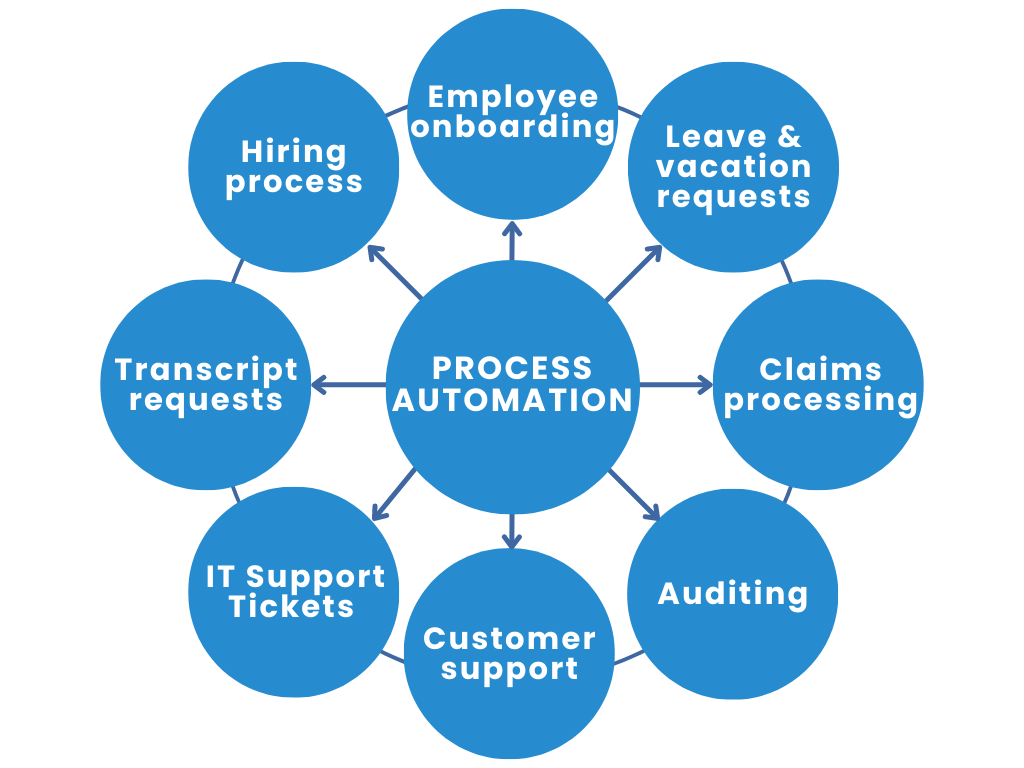Process automation is an innovative approach for businesses keen on streamlining operations, increasing productivity, and slashing costs. However, implementing business process automation can seem intimidating at first glance. To shed light on the immense potential offered by automation processes, let’s examine 15 extraordinary examples of process automation across various industries.
What exactly is process automation?
Process automation involves using technology to automate complex business processes that were traditionally done manually, improving efficiency, accuracy, and effectiveness. By implementing advanced software solutions, organizations can automate repetitive tasks, streamline operations, and reduce costs while maintaining consistency and precision. This approach saves time and allows employees to focus on strategic initiatives, fostering innovation and boosting productivity.
Why use process automation?
Imagine a world where routine and complex tasks seamlessly flow, unlocking remarkable efficiency and freeing up resources for bold, strategic initiatives. By reducing the risk of human error, automation ensures that every task shines with accuracy and consistency, empowering teams to focus on what truly matters. With process automation, you’re not just adapting to market changes; you’re leading the charge, igniting creativity, and cultivating a competitive edge that propels sustained growth. This is more than just a change; it’s the beginning of a new era, where businesses can truly reach their potential.
15 process automation examples
Now let’s have a look at more concrete examples of process automation. These use cases demonstrate how automation can drive efficiency, accuracy, and innovation, transforming businesses into lean, agile, and forward-thinking organizations. From HR to finance, logistics to customer support, get ready to be inspired by the power of end-to-end business process automation.
- Hiring process
- Employee onboarding
- Employee analytics and retention
- Employee leave and vacation requests
- Transcript requests and processing
- Claims processing
- Accounts receivable
- Purchase orders
- Operations management
- Logistics and supply chain management
- Customer support
- New account openings
- Auditing
- IT support tickets
- Contract management
Hiring process
Processing hundreds or even thousands of applications for a single job posting can be overwhelming. Through process automation, businesses can efficiently sift through and identify suitable candidates for the position.
Employee onboarding
Recruiting and filling open positions is only the beginning. Once hired, HR department tasks include training employees, collecting information, assigning assets, and granting system access. Drawn-out employee onboarding processes can lead to unhappy new hires and prolonged periods of unproductivity.
Process automation can streamline the lengthy process of new employee onboarding. It ensures the consistent execution of tasks like employee training, information gathering, asset allocation, and system access granting. Automating these processes can significantly increase the likelihood of retaining new hires and minimizes onboarding errors.
Employee analytics and retention
Automated processes can augment the ability of organizations to gather and scrutinize key performance indicators. This invaluable information can improve employee productivity and job satisfaction. Automating support features (such as an employee help desk) ensures your team members have everything they need to succeed.
Employee leave and vacation requests
Automation processes can transmute the tedious task of tracking employee leave and vacation requests into a swift and seamless process. Automated workflows allow employees to submit and track requests electronically, thereby enhancing transparency and efficiency.
Transcript requests and processing
Colleges and universities can leverage process automation controls for handling the colossal volume of transcript requests they receive every year. University-foccan speed up processing times and lift the administrative burden off staff members.
Schools are also tasked with processing transfer applications. With automation tools for transfer credit evaluations, relevant coursework is recognized and inputted. This eliminates the need for manual review and data entry, allowing schools to be more responsive while making fewer mistakes.
Claims processing
Insurance agencies use automation to manage and process a massive number of claims. Automation solutions serve many important functions. These include tasks like claims intake, assessing damages, sending out settlement notices, and processing payments. With automation, insurance companies can also gain powerful insights through the extraction and analysis of traditionally inaccessible unstructured data sources.

Accounts receivable
Success in business requires consistent and predictable cash flow. With automation, organizations can seamlessly create invoices, deliver them on specified dates, send payment reminders to customers, maintain electronic payment records, and assist with account reconciliation. In addition to getting paid faster, process automation reduces the occurrence of costly human mistakes.
Purchase orders
Purchase order requests are a common business process across industries. Traditional inefficient processes involve employees tracking down one or more supervisors for their signatures. With process automation, purchase order requests are automatically routed to the appropriate party for review. Additional features include notifications and reminders, the ability to track requests, and the creation of audit trails by storing completed purchase orders.
Operations management
Business process management software offers an intuitive dashboard that provides a global overview of open tasks and projects, allowing organizations to preempt potential bottlenecks and sustain productivity.
Logistics and supply chain management
Another business process automation example is within logistics and supply chain management. BPA enhances communication channels with suppliers, distributors, and customers. It also removes manual processes like inventory management and customer support. Organizations can process orders quicker, increase productivity, and provide excellent customer service.
Customer support
As organizations seek to improve the customer experience, many are turning to automation solutions like chatbots to offer 24/7 support. Chatbots are computer programs that use natural language processing (NLP), machine learning (ML), and artificial intelligence (AI) to process human interactions. Automation examples in business reveal that organizations are increasingly opting for automation solutions like chatbots to provide 24/7 customer support.
Despite the commonly held perception that chatbots are a nuisance, research suggests otherwise. In fact, some 55% of customers prefer to communicate with companies through a messenger. Consider using a chatbot to screen customer communications or to provide round-the-clock support.
New account openings
In the banking industry, new anti-money laundering and know-your-customer regulations have burdened the process of opening new accounts. Customers expect a quick, seamless account opening process. Process automation in the banking industry can simplify data collection, improve compliance, and enhance the customer experience.
Auditing
Automating the auditing process can enhance efficiency and provide powerful insights. Examples of automation in this area include robotic process automation (RPA), which performs audit tasks around the clock at enhanced speeds more than double that of manual audits.
IT support tickets
Automation of an IT ticketing system makes it easy for organizations to manage support requests while saving time and money. Process automation solutions automatically assign and track requests, send important reminders, and maintain detailed logs and records. Stakeholders spend less time on tasks like assigning work and following up and more on high-value tasks.
Other IT department workflows may include product lifecycle, quality assurance, and release cycles as process automation examples.
Contract management
Contract management systems help organizations get rid of paper-based processes while offering transparency and consistency when negotiating contracts. A contract management automation process offers powerful features like editing, approval workflows, electronic signatures, email notifications, accessibility, and enhanced security.
ProcessMaker is a powerful low-code business process management software that helps organizations throughout the world transform their operations through process automation. We want to help you find the right fit. Chat with one of our experts to learn more





